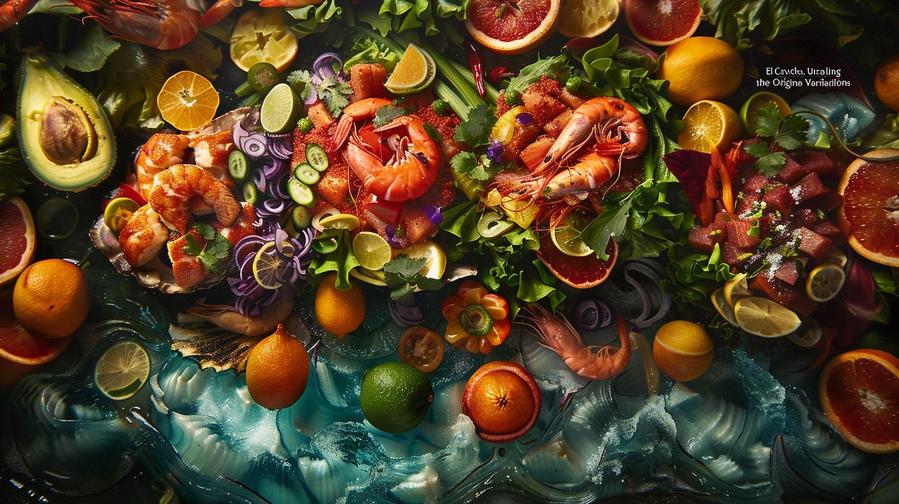Dive into the vibrant world of Latin cuisine with "El Ceviche: Unraveling the Origins and Variations". This sizzling journey uncovers the roots of ceviche, explores its diverse variations, and invites you to recreate this Latin culinary masterpiece in your own kitchen. From Peru's tangy pescado to Mexico's zesty camarón, come savor the rich tapestry of flavors that define this iconic Latin dish. Ready to start your culinary adventure? Let's dive in!
TL;DR:
- Ceviche’s origins trace back to the Moche culture in Peru. The dish is a combination of fresh seafood, citrus marinades, with variations from different countries.
- Peruvian ceviche involves fresh fish, key lime juice, chili peppers, and onions, while Mexican variant includes tomato and avocado. Ecuadorian style lightly poaches seafood before marination.
- Authentic Peruvian, Mexican, and Ecuadorian Ceviches can be enjoyed at specialized twin restaurants with a focus on fresh seafood.
- Creativity in ceviche preparation can involve experimenting with ingredients like ají, tropical fruits as mango, and textures from cassava.

What are the origins and variations of Ceviche?
Let's dive into the past of el ceviche. Its roots trace back to pre-Hispanic civilizations and the Moche culture in Peru. The Inca Empire also enjoyed this dish. Ceviche is now a flagship dish in Peru and a symbol of their cultural heritage.
How was Ceviche originated?
The Moche people, who lived along the Pacific Ocean, adored fish and seafood. They invented a way to preserve their catch using the fruit from the coastal totumo tree, which is similar to limes. This early receta de ceviche peruano was born.
What makes Peruvian Ceviche distinct?
Peruvian ceviche, or ceviche de pescado peruano, is a simple dish. It involves fresh fish marinated in key lime juice. The addition of chili peppers and onions gives it a tangy punch. Some regional variations might add their unique touch, but the essence of Peruvian ceviche remains the same.
How is Leche de Tigre used in Ceviche?
Cómo hacer leche de tigre? Well, this 'tiger’s milk' is the citrusy marinade used in ceviche. It adds a zesty flavor and cures the fish. In Peru, this marinade is so loved that it's often served in a glass as a drink alongside the dish!
Other countries like Mexico, Ecuador, and Chile have their versions of ceviche. The ceviche de camarón peruano, for instance, incorporates shrimps. The variations are vast, but the heart of ceviche – fresh seafood and citrus marinade – remains consistent. This dish is a delightful culinary journey that showcases the rich seafood bounty of the Pacific Ocean.
How to Make a Classic Peruvian Ceviche?
Peruvian Ceviche, a dish I've known and loved for years, has a simple recipe. Let's dive into the ingredients and methods that make it unique.
What are the Essential Ingredients for Peruvian Ceviche?
The ingredients for a classic Peruvian Ceviche are few but full of flavor. You need fresh, raw white fish, key lime juice, red onions, chilli peppers (ají limo), cilantro, and salt. These are the core ingredients, the soul of our beloved ceviche.
What is the Traditional Method to Prepare Peruvian Ceviche?
To prepare Peruvian Ceviche, start by cutting the fish into bite-size pieces. Next, marinate the fish in lime juice, a process known as "cooking" the fish. Add sliced onions, chopped cilantro, diced chili peppers, and salt. Mix, and let it sit for a few minutes, allowing the flavors to meld together. The key is freshness; consume immediately after preparation.
Any Easy Recipes to Make Peruvian Ceviche at Home?
Indeed, making Peruvian Ceviche at home is easy. Follow the same steps I described earlier. Remember, the type of fish you use matters. Sea bass, snapper, or halibut are excellent choices. For an authentic Peruvian experience, accompany your ceviche with sweet potato and choclo (Peruvian corn).

How is Mexican Ceviche different?
Mexican ceviche, or "ceviche mexicano," brings its own flair to this dish. As we delve into the world of ceviche, let's first understand the variations in Mexican ceviche, how to whip it up at home, and the unique ingredients that make it sing.
What variations exist in Mexican Ceviche?
Mexican ceviche, much like its counterparts, is a citrus-marinated seafood delight. Yet, it stands out with its own unique twists. "Receta de ceviche mexicano" often includes tomato and avocado, and tomato sauce is a common addition, except in some regions. One popular variant is "ceviche de camarón mexicano," where shrimp takes center stage.
How to prepare homemade Mexican Ceviche?
If you're wondering, "cómo hacer ceviche mexicano," it's quite simple. Fresh fish or shrimp is marinated in lime juice. Once the seafood is cured, onions, tomatoes, chilies, and cilantro are added. Avocado is an optional but delicious addition. Mexican ceviche must be eaten fresh to avoid food poisoning.
What unique ingredients are added to Mexican Ceviche?
Mexican ceviche shines with its use of ripe avocados and juicy tomatoes, lending a rich, creamy texture that beautifully contrasts the sharp citrus tang. Cilantro adds a burst of freshness, while chili peppers give it an exciting kick. These unique additions truly make ceviche mexicano a culinary celebration.
What does Ecuadorian Ceviche bring on the table?
The allure of ceviche ecuatoriano is profound. Its charm lies in its unique blend of flavors and textures. Let's delve into this culinary delight.
What makes Ecuadorian Ceviche unique?
Think of ceviche de pescado ecuatoriano or ceviche de camarón ecuatoriano. The key difference lies in the dish's essence. Unlike other variants, the seafood isn't fully cooked by citrus. It's lightly poached, then marinated in lime juice, rendering it succulent and flavorful.
How to prepare Ecuadorian Ceviche at home?
Making receta de ceviche ecuatoriano at home is a joyous task. Choose your seafood. Poach it lightly. Let it cool. Then, marinate it in a citrusy dressing. Toss in diced tomatoes, onions, cilantro, and a hint of ketchup for a tangy twist. The final touch? A dash of mustard and a drizzle of oil. Simple yet sublime!
How do seafood components vary in Ecuadorian Ceviche?
Seafood takes center stage in ceviche ecuatoriano. The star could be fish, shrimp, or even a mix. The choice depends on your palate. Some prefer the delicate texture of fish. Others love the firm bite of shrimp. In Ecuador, it's common to find mixed ceviche, a delightful seafood medley. The variations are endless, each with its own charm.
In essence, Ecuadorian ceviche is a celebration of the sea. It's a dance of flavors that leaves you yearning for more. So, next time you crave a tangy delight, why not give ceviche ecuatoriano a try?

Which restaurants serve the best Ceviche?
As an expert in Latin cuisine, I've eaten my fair share of ceviche. But where can you find the best? Let's dive in.
Where to find the best Peruvian Ceviche in town?
We can't talk about ceviche without mentioning Peruvian cuisine. The best spot? Look for "restaurantes peruanos cerca de mí" on your map. The standout? El Ceviche in Sarasota, Florida. Their dish is a perfect blend of citrus and spice that will leave you wanting more.
Which Mexican restaurants serve mouth-watering Ceviche?
Mexican ceviche, or "ceviche mexicano," is a treat all its own. It often includes tomato and avocado for a unique twist. One place that does it justice is Mariscos El Guero Baja Style Ceviche Bar. This spot offers a range of ceviche dishes that are a feast for the senses.
Any recommended spots for tasting Ecuadorian Ceviche?
Ecuadorian ceviche is another variation you must try. It's made with fish or shrimp marinated in lemon juice. You can find this version at any authentic Ecuadorian restaurant. Remember, the best ceviche is always freshly made and consumed right away. So, always ask for the fresh catch of the day.
This journey through ceviche hotspots shows us one thing: no matter where you go, there's a ceviche waiting to tantalize your taste buds. So, why not start your culinary adventure today?
How to add a creative twist to your Ceviche?
Ceviche is a dish that calls for creativity, allowing you to be bold in your choice of ingredients. It's a canvas where you can let your culinary imagination run wild.
How can you experiment with Ceviche ingredients?
The beauty of ceviche lies in its versatility. You can always spice up your ceviche con ají or add a crunch with ceviche con cebolla. The key is to balance the flavors and textures. For instance, the heat from ají can be balanced with the sweetness of the onions.
What is the role of tropical fruits like Mango in Ceviche?
Incorporating tropical fruits like mango can elevate your ceviche. Ceviche con mango isn't just a twist, it's a flavor revelation. The sweetness and acidity of mango can complement the fish perfectly, adding a layer of complexity to the dish.
How can Yuca enhance your Ceviche experience?
Ceviche con yuca can be a game-changer. Yuca, or cassava, adds a delightful texture contrast to the soft fish. Its mild flavor allows it to soak up the ceviche marinade, making every bite a burst of flavor. So next time you make ceviche, don't hesitate to experiment and make it your own!
We've journeyed through the vibrant world of ceviche, from its Peruvian roots to its Mexican and Ecuadorian variations. We've learned about the essential ingredients and the unique twists you can add. Now it's your turn to dive into this culinary adventure. Whether you're making it at home or exploring it at a local restaurant, savor the rich tastes and traditions that ceviche brings to the table. Enjoy your flavorful journey through Latin cuisine!



